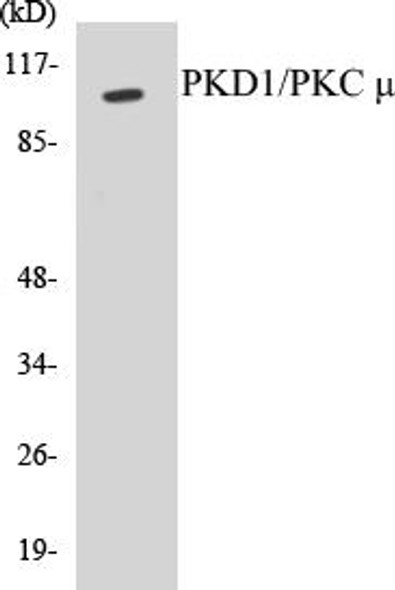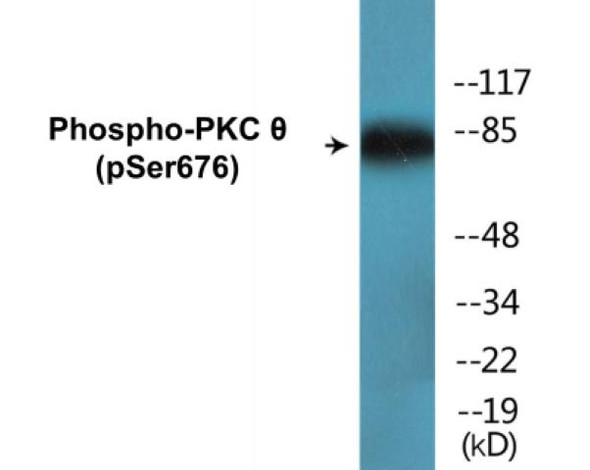PKD1/PKC mu (Phospho-Tyr463) Colorimetric Cell-Based ELISA Kit
- SKU:
- CBCAB01380
- Product Type:
- ELISA Kit
- ELISA Type:
- Cell Based Phospho Specific
- Research Area:
- Cardiovascular
- Reactivity:
- Human
- Mouse
- Rat
- Detection Method:
- Colorimetric
Description
PKD1/PKC mu (Phospho-Tyr463)Colorimetric Cell-Based ELISA Kit
The PKD1/PKC Mu Phospho-Tyr463 Colorimetric Cell-Based ELISA Kit is a cutting-edge tool for studying phosphorylation events in cell signaling pathways. This kit allows for the precise measurement of phosphorylated PKD1 and PKC Mu at the Tyr463 residue, providing valuable insights into their activation and function.With its high sensitivity and specificity, this ELISA kit delivers accurate and reproducible results, making it an essential tool for researchers studying signal transduction pathways and cellular signaling cascades. Whether investigating cell cycle regulation, cell growth, or apoptosis, this kit is a valuable resource for deciphering the complex mechanisms underlying these processes.
By targeting phosphorylation at the Tyr463 residue of PKD1 and PKC Mu, this kit offers unique opportunities to explore the impact of these modifications on cell signaling and protein function. With its user-friendly protocol and robust performance, the PKD1/PKC Mu Phospho-Tyr463 Colorimetric Cell-Based ELISA Kit is the ideal choice for researchers seeking to unravel the intricacies of cell signaling pathways. Unlock new insights into cell biology with this innovative ELISA kit.
| Product Name: | PKD1/PKC mu (Phospho-Tyr463) Colorimetric Cell-Based ELISA |
| Product Code: | CBCAB01380 |
| ELISA Type: | Cell-Based |
| Target: | PKD1/PKC mu (Phospho-Tyr463) |
| Reactivity: | Human, Mouse, Rat |
| Dynamic Range: | > 5000 Cells |
| Detection Method: | Colorimetric 450 nm |
| Format: | 2 x 96-Well Microplates |
The PKD1/PKC mu (Phospho-Tyr463) Colorimetric Cell-Based ELISA Kit is a convenient, lysate-free, high throughput and sensitive assay kit that can detect PKD1/PKC mu protein phosphorylation and expression profile in cells. The kit can be used for measuring the relative amounts of phosphorylated PKD1/PKC mu in cultured cells as well as screening for the effects that various treatments, inhibitors (ie. siRNA or chemicals), or activators have on PKD1/PKC mu phosphorylation.
Qualitative determination of PKD1/PKC mu (Phospho-Tyr463) concentration is achieved by an indirect ELISA format. In essence, PKD1/PKC mu (Phospho-Tyr463) is captured by PKD1/PKC mu (Phospho-Tyr463)-specific primary (1ø) antibodies while the HRP-conjugated secondary (2ø) antibodies bind the Fc region of the 1ø antibody. Through this binding, the HRP enzyme conjugated to the 2ø antibody can catalyze a colorimetric reaction upon substrate addition. Due to the qualitative nature of the Cell-Based ELISA, multiple normalization methods are needed:
| 1. | A monoclonal antibody specific for human GAPDH is included to serve as an internal positive control in normalizing the target absorbance values. |
| 2. | Following the colorimetric measurement of HRP activity via substrate addition, the Crystal Violet whole-cell staining method may be used to determine cell density. After staining, the results can be analysed by normalizing the absorbance values to cell amounts, by which the plating difference can be adjusted. |
| Database Information: | Gene ID: 5587, UniProt ID: Q15139, OMIM: 605435, Unigene: Hs.508999 |
| Gene Symbol: | KPCD1 |
| Sub Type: | Phospho |
| UniProt Protein Function: | PRKD1: a CAMK kinase of the PKD family. Cleavage by caspase-3 following DNA damage activates it and alters its subcellular localization. Sensitizes cells to apoptosis induced by genotoxic stress. Its cleavage is blocked in cells that over-express the anti-apoptotic Bcl-x(L) protein. Expression of a caspase-resistant mutant partially inhibits DNA damage-induced apoptosis. Its activation by TLR ligands is dependent on MyD88, IRAK4 and -1, but not TRAF6. Essential for MyD88-dependent proinflammatory immune responses. Activated by diacylglycerol and phorbol esters. Binds to the trans-Golgi network and regulates the fission of transport carriers specifically destined to the cell surface. Colocalizes with F-actin at peripheral F-actin-rich structures in membrane ruffles at the edge of lamellipodia in cervical carcinoma cells. Substrates reportedly include critical regulatory proteins including CREB, SSH1L, CTNNB1, HDACs 5 and 7, PKD1, HPK1, MARK2, PIP5K2A, PPP1R14A |
| UniProt Protein Details: | Protein type:EC 2.7.11.13; Protein kinase, CAMK; Motility/polarity/chemotaxis; Autophagy; Protein kinase, Ser/Thr (non-receptor); Kinase, protein; CAMK group; PKD family Chromosomal Location of Human Ortholog: 14q11 Cellular Component: cytoplasm; cytosol; Golgi apparatus; integral to plasma membrane; plasma membrane; trans-Golgi network Molecular Function:identical protein binding; kinase activity; protein binding; protein kinase C activity; protein serine/threonine kinase activity Biological Process: activation of CREB transcription factor; activation of NF-kappaB transcription factor; cell proliferation; Golgi organization and biogenesis; Golgi vesicle transport; integrin-mediated signaling pathway; negative regulation of endocytosis; peptidyl-serine phosphorylation; positive regulation of angiogenesis; positive regulation of blood vessel endothelial cell migration; positive regulation of endothelial cell proliferation; positive regulation of I-kappaB kinase/NF-kappaB cascade; positive regulation of osteoblast differentiation; positive regulation of peptidyl-serine phosphorylation; positive regulation of transcription from RNA polymerase II promoter; protein amino acid autophosphorylation; protein amino acid phosphorylation; Ras protein signal transduction; regulation of protein stability; signal transduction; sphingolipid biosynthetic process; vascular endothelial growth factor receptor signaling pathway |
| NCBI Summary: | PRKD1 is a serine/threonine kinase that regulates a variety of cellular functions, including membrane receptor signaling, transport at the Golgi, protection from oxidative stress at the mitochondria, gene transcription, and regulation of cell shape, motility, and adhesion (summary by Eiseler et al., 2009 [PubMed 19329994]).[supplied by OMIM, Nov 2010] |
| UniProt Code: | Q15139 |
| NCBI GenInfo Identifier: | 209572639 |
| NCBI Gene ID: | 5587 |
| NCBI Accession: | Q15139.2 |
| UniProt Secondary Accession: | Q15139,A6NL64, B2RAF6, |
| UniProt Related Accession: | Q15139 |
| Molecular Weight: | 101,704 Da |
| NCBI Full Name: | Serine/threonine-protein kinase D1 |
| NCBI Synonym Full Names: | protein kinase D1 |
| NCBI Official Symbol: | PRKD1 |
| NCBI Official Synonym Symbols: | PKD; PKCM; PRKCM; PKC-MU |
| NCBI Protein Information: | serine/threonine-protein kinase D1 |
| UniProt Protein Name: | Serine/threonine-protein kinase D1 |
| UniProt Synonym Protein Names: | Protein kinase C mu type; Protein kinase D; nPKC-D1; nPKC-mu |
| Protein Family: | Serine/threonine-protein kinase |
| UniProt Gene Name: | PRKD1 |
| UniProt Entry Name: | KPCD1_HUMAN |
| Component | Quantity |
| 96-Well Cell Culture Clear-Bottom Microplate | 2 plates |
| 10X TBS | 24 mL |
| Quenching Buffer | 24 mL |
| Blocking Buffer | 50 mL |
| 15X Wash Buffer | 50 mL |
| Primary Antibody Diluent | 12 mL |
| 100x Anti-Phospho Target Antibody | 60 µL |
| 100x Anti-Target Antibody | 60 µL |
| Anti-GAPDH Antibody | 60 µL |
| HRP-Conjugated Anti-Rabbit IgG Antibody | 12 mL |
| HRP-Conjugated Anti-Mouse IgG Antibody | 12 mL |
| SDS Solution | 12 mL |
| Stop Solution | 24 mL |
| Ready-to-Use Substrate | 12 mL |
| Crystal Violet Solution | 12 mL |
| Adhesive Plate Seals | 2 seals |
The following materials and/or equipment are NOT provided in this kit but are necessary to successfully conduct the experiment:
- Microplate reader able to measure absorbance at 450 nm and/or 595 nm for Crystal Violet Cell Staining (Optional)
- Micropipettes with capability of measuring volumes ranging from 1 µL to 1 ml
- 37% formaldehyde (Sigma Cat# F-8775) or formaldehyde from other sources
- Squirt bottle, manifold dispenser, multichannel pipette reservoir or automated microplate washer
- Graph paper or computer software capable of generating or displaying logarithmic functions
- Absorbent papers or vacuum aspirator
- Test tubes or microfuge tubes capable of storing ≥1 ml
- Poly-L-Lysine (Sigma Cat# P4832 for suspension cells)
- Orbital shaker (optional)
- Deionized or sterile water
*Note: Protocols are specific to each batch/lot. For the correct instructions please follow the protocol included in your kit.
| Step | Procedure |
| 1. | Seed 200 µL of 20,000 adherent cells in culture medium in each well of a 96-well plate. The plates included in the kit are sterile and treated for cell culture. For suspension cells and loosely attached cells, coat the plates with 100 µL of 10 µg/ml Poly-L-Lysine (not included) to each well of a 96-well plate for 30 minutes at 37 °C prior to adding cells. |
| 2. | Incubate the cells for overnight at 37 °C, 5% CO2. |
| 3. | Treat the cells as desired. |
| 4. | Remove the cell culture medium and rinse with 200 µL of 1x TBS, twice. |
| 5. | Fix the cells by incubating with 100 µL of Fixing Solution for 20 minutes at room temperature. The 4% formaldehyde is used for adherent cells and 8% formaldehyde is used for suspension cells and loosely attached cells. |
| 6. | Remove the Fixing Solution and wash the plate 3 times with 200 µL 1x Wash Buffer for five minutes each time with gentle shaking on the orbital shaker. The plate can be stored at 4 °C for a week. |
| 7. | Add 100 µL of Quenching Buffer and incubate for 20 minutes at room temperature. |
| 8. | Wash the plate 3 times with 1x Wash Buffer for 5 minutes each time. |
| 9. | Add 200 µL of Blocking Buffer and incubate for 1 hour at room temperature. |
| 10. | Wash 3 times with 200 µL of 1x Wash Buffer for 5 minutes each time. |
| 11. | Add 50 µL of 1x primary antibodies Anti-PKD1/PKC mu (Phospho-Tyr463) Antibody, Anti-PKD1/PKC mu Antibody and/or Anti-GAPDH Antibody) to the corresponding wells, cover with Parafilm and incubate for 16 hours (overnight) at 4 °C. If the target expression is known to be high, incubate for 2 hours at room temperature. |
| 12. | Wash 3 times with 200 µL of 1x Wash Buffer for 5 minutes each time. |
| 13. | Add 50 µL of 1x secondary antibodies (HRP-Conjugated AntiRabbit IgG Antibody or HRP-Conjugated Anti-Mouse IgG Antibody) to corresponding wells and incubate for 1.5 hours at room temperature. |
| 14. | Wash 3 times with 200 µL of 1x Wash Buffer for 5 minutes each time. |
| 15. | Add 50 µL of Ready-to-Use Substrate to each well and incubate for 30 minutes at room temperature in the dark. |
| 16. | Add 50 µL of Stop Solution to each well and read OD at 450 nm immediately using the microplate reader. |
(Additional Crystal Violet staining may be performed if desired – details of this may be found in the kit technical manual.)










